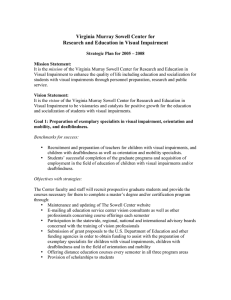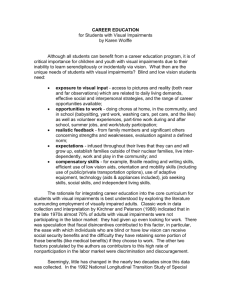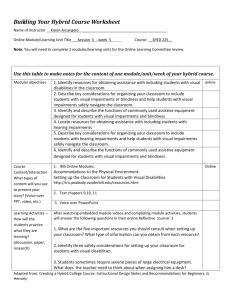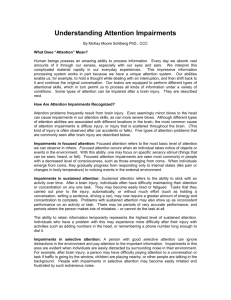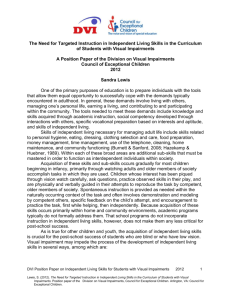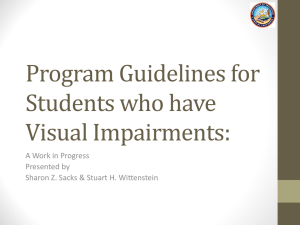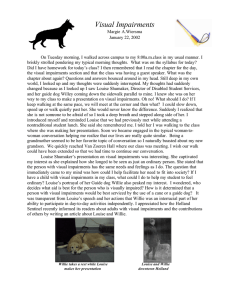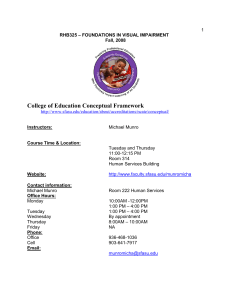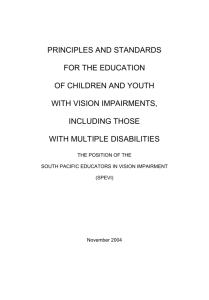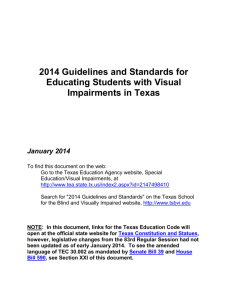The Need for Targeted Instruction in Independent Living Skills in the
advertisement
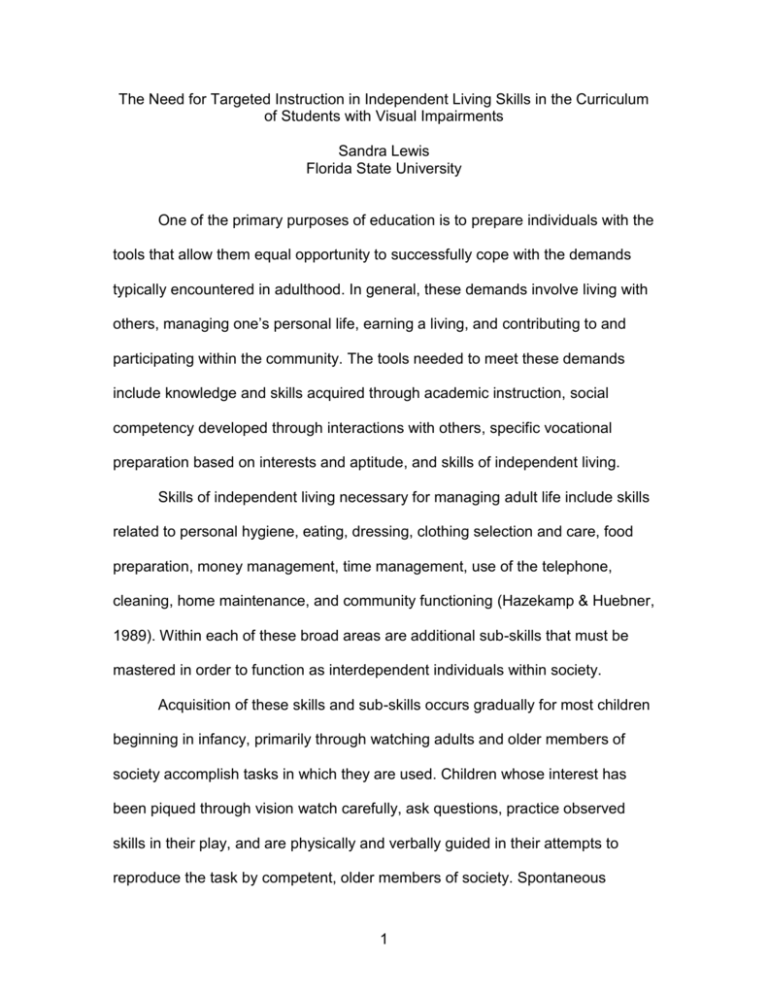
The Need for Targeted Instruction in Independent Living Skills in the Curriculum of Students with Visual Impairments Sandra Lewis Florida State University One of the primary purposes of education is to prepare individuals with the tools that allow them equal opportunity to successfully cope with the demands typically encountered in adulthood. In general, these demands involve living with others, managing one’s personal life, earning a living, and contributing to and participating within the community. The tools needed to meet these demands include knowledge and skills acquired through academic instruction, social competency developed through interactions with others, specific vocational preparation based on interests and aptitude, and skills of independent living. Skills of independent living necessary for managing adult life include skills related to personal hygiene, eating, dressing, clothing selection and care, food preparation, money management, time management, use of the telephone, cleaning, home maintenance, and community functioning (Hazekamp & Huebner, 1989). Within each of these broad areas are additional sub-skills that must be mastered in order to function as interdependent individuals within society. Acquisition of these skills and sub-skills occurs gradually for most children beginning in infancy, primarily through watching adults and older members of society accomplish tasks in which they are used. Children whose interest has been piqued through vision watch carefully, ask questions, practice observed skills in their play, and are physically and verbally guided in their attempts to reproduce the task by competent, older members of society. Spontaneous 1 instruction is provided as needed within the naturally occurring context of the task and often involves demonstration and modeling by competent others, specific feedback on the child’s attempt, and encouragement to practice the task, first while helping, then independently. Because acquisition of these skills occurs primarily within home and community environments, academic programs typically do not incorporate specific instruction of them. That school programs do not incorporate instruction in these skills, however, does not make them any less critical for post-school success. As is true for other children and youth, the acquisition of independent living skills is crucial for the post-school success of students who are blind or who have low vision. Visual impairment interferes with the process of the development of independent living skills in several ways. Children do not clearly observe others performing tasks, so may not be aware that the tasks even exist or that other children attempt them in play and real situations. Children do not clearly observe the whole task or the techniques that others use to perform independent living skills, so do not have a cognitive model upon which to build skills that incorporates an understanding of the whole task or its component parts. Instruction in independent living skills is complicated when the learner cannot easily benefit from demonstration and modeling and when the person providing the instruction does not have a well-established 2 understanding of appropriate strategies for overcoming the impact of visual impairment on learning. Children with visual impairment are not given enough opportunities to practice new skills until they become fluent. In order to achieve one of the goals of education, which is to be prepared with the tools that allow equal opportunity to successfully cope with the demands of adulthood, it is incumbent that students with visual impairments transition from school with well developed independent living skills. Teachers of students with visual impairments (TVIs) must include among their professional roles the annual assessment of every student’s skill level in each independent living skill area and compare that skill level to the skill levels being acquired by their same age peers, keeping in mind that peers are often learning about skills long before they are asked to utilize them. For students for whom gaps in the development of independent living skills are identified, TVIs must advocate for the inclusion of appropriate goals related to these functional skills on Family Service Plans and Individualized Education Programs (IEPs), as well as for the time and resources to teach these skills to students. Strong advocacy is key, since it is tempting for people unfamiliar with the long-term outcomes of many students with visual impairments to believe that the acquisition of academic skills is of greater importance to postschool success. Experienced educators of students who are blind or who have low vision, however, recognize that students without well-developed independent living skills struggle to utilize academic knowledge within adult education, 3 vocational, and community environments. A second role, then, of TVIs is to help administrators, parents, and other members of IEP teams to realize the critical importance of including instruction in independent living skills in the curriculum of students who need it. Finally, TVIs must be prepared to provide carefully designed formal instruction in independent living skills to students from infancy until age 22 and to assist students’ parents to know how to introduce, teach, and reinforce these skills within the home. Instruction should be targeted to meet the assessed needs of each student, should incorporate appropriate alternative sensory methods, should focus on safety, fluency, and efficiency, and should facilitate development of students’ problem solving, organizational, sensory efficiency, and selfadvocacy skills. A much as possible, instruction should occur within naturally occurring environments and contexts, but the limited availability of either or both of these conditions should not prevent instruction from occurring. As part of their responsibilities, TVIs must maintain longitudinal records of students’ acquisition of skills and assure that the development of more complex skills within any area occurs when appropriate. Students with visual impairments deserve to function throughout their childhood and youth with independent living skills similar to those of their peers. Similarly, teens with visual impairments deserve to leave high school ready to function in the adult school, community, and work environments to which they transition. Through assessment, advocacy, collaboration with families, targeted 4 formal instruction, and a commitment to positive post-school outcomes, these objectives are much more likely to be achieved. Position It is the position of DVI that children and youth with visual impairments require carefully designed instruction in independent living skills, facilitated by individuals who understand the impact of visual impairment on the acquisition of general information and learning. Development of independent living skills is vital for full integration in society. Specialized assessment and instruction must be provided. In addition, sufficient time, resources, and support must be available to teachers of students with visual impairments to allow them to address all the educational needs of their students, including those related to independent living skills. Teachers, parents, and administrators must work together in these efforts to achieve the promise of equal opportunity, which is the overarching goal of education. Hazekamp, J., & Huebner, K. M. (1989). Program planning and evaluation for blind and visually impaired students: National guidelines for educational excellence. New York: American Foundation for the Blind. 5

